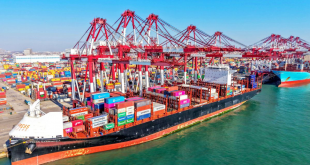Zhou Lijun

An aerial drone photo of the Harbin Ice and Snow World, a unique winter tourist and cultural festival, in Harbin, northeast China’s Heilongjiang Province, December 21, 2024. /Xinhua
China’s snow and ice economy is a comprehensive economic system driven by multiple industries. In recent years, with the improvement of the national living standard and greater health consciousness, the sector has emerged rapidly, becoming an important engine for regional economic development.
This booming development reflects new trends in the consumer sector. People’s pursuit of health and a quality life is becoming increasingly evident. Ice and snow sports can both strengthen the body and bring people closer to nature, aligning with their aspirations for a healthy lifestyle. Hence the demand for personalized, diverse and experiential consumption has significantly increased. Sports like skiing and ice skating satisfy people’s desire for novelty and unique experiences, while also stimulating consumer vitality.
It is foreseeable that as the popularity of ice and snow sports continues to rise, the ice and snow economy will release greater consumption potential, injecting new momentum into economic development.
According to a research report on the development of China’s ice and snow industry, the value of the sector surged from 270 billion Chinese yuan (about $37.6 billion) in 2015 to 970 billion yuan (about $135 billion) in 2024. In 2025, it is expected to reach 1 trillion yuan (about $0.14 trillion) . This growth is primarily driven by the popularity of ice and snow sports and the rise of ice and snow tourism.
In recent years, the government has introduced several policies to support the development of the industry, setting the goal of reaching 1.2 trillion yuan (about $0.17 trillion) by 2027 and 1.5 trillion yuan (about $0.21 trillion) by 2030. The rapid development of the ice and snow economy is inseparable from the dual drive of policy support, which provides a favorable development environment, and market demand, which brings significant potential.
The impact of the snow and ice economy can be seen in several areas:
It has seen the popularity of ice and snow sports soar with the number of people participating in them already reaching 313 million. This number is expected to exceed 400 million by 2025.
Skiers enjoy themselves at the Beidahu Ski Resort in Jilin City, northeast China’s Jilin Province, November 23, 2024. /Xinhua
The ice and snow equipment manufacturing industry has also grown. According to data from the Ministry of Industry and Information Technology, the number of ice and snow equipment manufacturing companies tripled from about 300 in 2015 to 900 in 2023, with sales revenue growing from less than 5 billion yuan (about $0.7 billion) to 22 billion yuan (about $3.06 billion). The market size for skiing equipment reached 15 billion yuan (about $2.09 billion) in 2023 and is expected to exceed 20 billion yuan (about $2.78 billion) by 2025.
New snowmaking technologies and intelligent skiing equipment have expanded the operating range of ski resorts and enhanced user experience and safety, giving the industry new vitality.
More and more ice and snow events and activities are being organized, increasing the influence of ice and snow sports and driving the development of related industries. During the 2022 Beijing Winter Olympics, ice and snow tourism revenue increased by more than 30 percent year on year. At the same time, ice and snow carnivals, ice and snow festivals and other events across the country attracted a large number of visitors, promoting the the ice and snow economy.
The ice and snow tourism market continues to heat up, boosting associated industries such as hotels, catering and transportation. A report by the China Tourism Academy projects that during the 2024-2025 winter season, 520 million ice and snow leisure tourism trips will be made, with tourism revenue expected to exceed 630 billion yuan (about $87.62 billion).
Technological innovations will continue to add momentum to the industry. The introduction of virtual reality technology and intelligent human-machine interfaces will break the geographical and climate limitations of ice and snow sports, enabling year-round activities. Moreover, innovations in smart skiing equipment, automated venues and other technologies will significantly enhance the user experience and safety, infusing new vitality into the economy.
Last but not the least, through collaboration with internationally renowned ice and snow brands, Chinese companies can jointly explore the global market. By hosting international ice and snow events and activities, China will enhance the international influence of its ice and snow economy and contribute “Chinese strength” to the global ice and snow economy.
Zhou Lijun, a special commentator on current affairs for CGTN, is the director of the National Sports Industry Research Base of Zhejiang University.
 Africa -China Review Africa -China Cooperation and Transformation
Africa -China Review Africa -China Cooperation and Transformation
